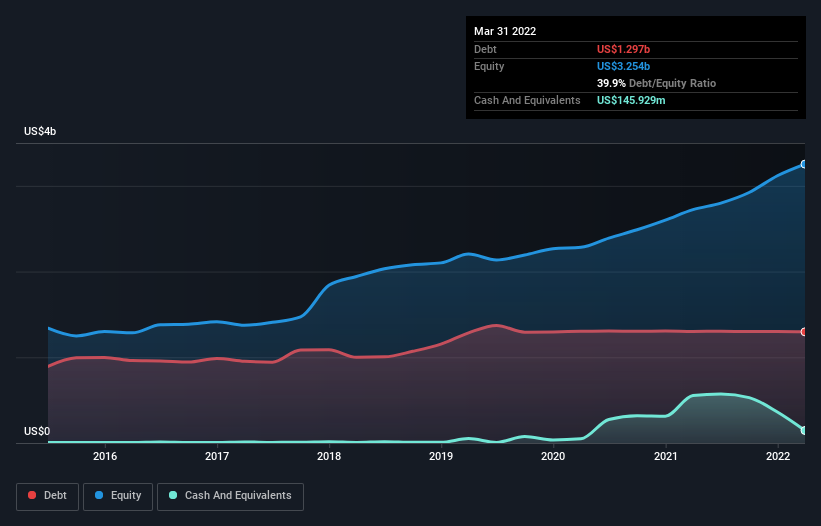- United States
- /
- Transportation
- /
- NasdaqGS:JBHT
These 4 Measures Indicate That J.B. Hunt Transport Services (NASDAQ:JBHT) Is Using Debt Reasonably Well

The external fund manager backed by Berkshire Hathaway's Charlie Munger, Li Lu, makes no bones about it when he says 'The biggest investment risk is not the volatility of prices, but whether you will suffer a permanent loss of capital.' It's only natural to consider a company's balance sheet when you examine how risky it is, since debt is often involved when a business collapses. We can see that J.B. Hunt Transport Services, Inc. (NASDAQ:JBHT) does use debt in its business. But the more important question is: how much risk is that debt creating?
When Is Debt A Problem?
Debt and other liabilities become risky for a business when it cannot easily fulfill those obligations, either with free cash flow or by raising capital at an attractive price. Ultimately, if the company can't fulfill its legal obligations to repay debt, shareholders could walk away with nothing. While that is not too common, we often do see indebted companies permanently diluting shareholders because lenders force them to raise capital at a distressed price. Of course, the upside of debt is that it often represents cheap capital, especially when it replaces dilution in a company with the ability to reinvest at high rates of return. The first step when considering a company's debt levels is to consider its cash and debt together.
See our latest analysis for J.B. Hunt Transport Services
What Is J.B. Hunt Transport Services's Net Debt?
The chart below, which you can click on for greater detail, shows that J.B. Hunt Transport Services had US$1.30b in debt in March 2022; about the same as the year before. On the flip side, it has US$145.9m in cash leading to net debt of about US$1.15b.

A Look At J.B. Hunt Transport Services' Liabilities
The latest balance sheet data shows that J.B. Hunt Transport Services had liabilities of US$1.78b due within a year, and liabilities of US$1.99b falling due after that. On the other hand, it had cash of US$145.9m and US$1.75b worth of receivables due within a year. So its liabilities outweigh the sum of its cash and (near-term) receivables by US$1.89b.
Given J.B. Hunt Transport Services has a humongous market capitalization of US$17.0b, it's hard to believe these liabilities pose much threat. Having said that, it's clear that we should continue to monitor its balance sheet, lest it change for the worse.
We measure a company's debt load relative to its earnings power by looking at its net debt divided by its earnings before interest, tax, depreciation, and amortization (EBITDA) and by calculating how easily its earnings before interest and tax (EBIT) cover its interest expense (interest cover). The advantage of this approach is that we take into account both the absolute quantum of debt (with net debt to EBITDA) and the actual interest expenses associated with that debt (with its interest cover ratio).
J.B. Hunt Transport Services's net debt is only 0.66 times its EBITDA. And its EBIT easily covers its interest expense, being 25.3 times the size. So you could argue it is no more threatened by its debt than an elephant is by a mouse. On top of that, J.B. Hunt Transport Services grew its EBIT by 53% over the last twelve months, and that growth will make it easier to handle its debt. When analysing debt levels, the balance sheet is the obvious place to start. But it is future earnings, more than anything, that will determine J.B. Hunt Transport Services's ability to maintain a healthy balance sheet going forward. So if you're focused on the future you can check out this free report showing analyst profit forecasts.
Finally, a business needs free cash flow to pay off debt; accounting profits just don't cut it. So the logical step is to look at the proportion of that EBIT that is matched by actual free cash flow. Looking at the most recent three years, J.B. Hunt Transport Services recorded free cash flow of 33% of its EBIT, which is weaker than we'd expect. That weak cash conversion makes it more difficult to handle indebtedness.
Our View
Happily, J.B. Hunt Transport Services's impressive interest cover implies it has the upper hand on its debt. But, on a more sombre note, we are a little concerned by its conversion of EBIT to free cash flow. Zooming out, J.B. Hunt Transport Services seems to use debt quite reasonably; and that gets the nod from us. After all, sensible leverage can boost returns on equity. When analysing debt levels, the balance sheet is the obvious place to start. But ultimately, every company can contain risks that exist outside of the balance sheet. These risks can be hard to spot. Every company has them, and we've spotted 2 warning signs for J.B. Hunt Transport Services (of which 1 makes us a bit uncomfortable!) you should know about.
When all is said and done, sometimes its easier to focus on companies that don't even need debt. Readers can access a list of growth stocks with zero net debt 100% free, right now.
New: Manage All Your Stock Portfolios in One Place
We've created the ultimate portfolio companion for stock investors, and it's free.
• Connect an unlimited number of Portfolios and see your total in one currency
• Be alerted to new Warning Signs or Risks via email or mobile
• Track the Fair Value of your stocks
Have feedback on this article? Concerned about the content? Get in touch with us directly. Alternatively, email editorial-team (at) simplywallst.com.
This article by Simply Wall St is general in nature. We provide commentary based on historical data and analyst forecasts only using an unbiased methodology and our articles are not intended to be financial advice. It does not constitute a recommendation to buy or sell any stock, and does not take account of your objectives, or your financial situation. We aim to bring you long-term focused analysis driven by fundamental data. Note that our analysis may not factor in the latest price-sensitive company announcements or qualitative material. Simply Wall St has no position in any stocks mentioned.
About NasdaqGS:JBHT
J.B. Hunt Transport Services
Provides surface transportation, delivery, and logistic services in the United States.
Excellent balance sheet, good value and pays a dividend.


